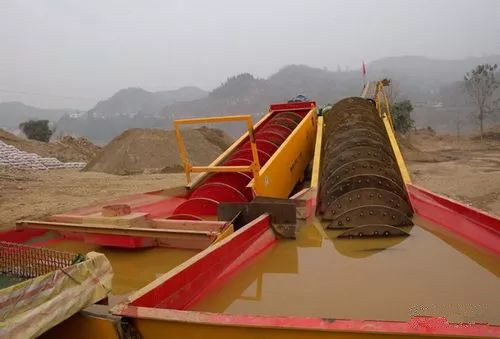According to industry figures, hundreds of thousands of tones of gravel & sand aggregates are needed for every kilometer of motorways and high-speed rails. Extremely fine sand must be of a caliber that satisfies construction-related criteria to be sold for a premium. This issue may be resolved with a modern spiral sand washing machine.
The new design, which is the outcome of scientific and technical advancement, may raise the quality of sand by 1 or 2 levels, providing clients with a variety of financial advantages.
New Type Spiral Sand washing machine
A form of sand washing machinery with a horizontal construction is the new type of spiral sand washing machine. Its technological innovation and design are an improvement over the standard sand washer, giving it the qualities of exceptional performance, great product size, relatively low operating cost, low carbon, & environmental protection.
It is extensively utilized in the building, highway, hydropower, sand & gravel, concrete mixing, etc. industries. It can process materials with medium to fine grains as well as coarse grains, including granite, basalt, shale, river pebbles, & pebbles.
The contaminants mixed in the sand are eliminated after washing, dewatering, & isolating by the spiral sand washer, and high-quality sand is obtained.
Types and Principle
The two varieties of spiral sand washers are single spiral and double spiral, respectively, depending on the number of internal spirals.
The double spiral sand washer can wash materials with significant muddy content and also has a better output and efficiency than the single spiral sand washer.
The construction is primarily made up of the sand washing tank, speed reducer, motor, main shaft, screw blade, and lifter support, regardless of whether it is a single spiral or double spiral sand washer. Simple and few pieces make up the construction.
A central structure is adopted by the rotor. The main shaft, where the screw blades have been mounted, is linked to the speed limiter for operation. The bearing device is driven by the impeller in a way that isolates it from water and other contaminants, protecting the end product from contamination and significantly enhancing cleaning performance.
There is a requirement to tilt the spiral sand washer. According to its basic design, a particular volume of water is continually pumped into the main tank while an equal amount of sand & gravel is fed from the feeder tank. The screw shaft is rotated at a set speed by the transmission component, which forces the material to mix with the water and causes them to repeatedly spin over and collide.
Whereas the clean sand is evacuated from the discharging port, the low specific gravity contaminants (such as mud, dust, etc.) are evacuated from the overflow silo.
In essence, the spiral sand washer works by mechanically washing different materials (such as sand, mud, and water) in a liquid while adhering to the spiral principle as well as the notion of varying sedimentation rates.
Advantages of Performance
The spiral sand washing machine has much more noteworthy benefits than a standard sand washer, and its productivity has grown by 50%.
- The spiral sand washer can clean thoroughly. It can successfully clean sand & gravel that has significant mud contaminants. Additionally, the sand’s low water content after washing—0.8%—meets the standards for high-grade materials;
- It may result in minimal sand loss and also has a big processing capacity, good washing, and selection efficiency. Consequently, it is frequently set up in massive sand manufacturing plants;
- It runs steadily and also has nearly no worn components. To prevent early machine damage from pollution and rust, the bearing is separated from sand and water, which significantly lowers the failure rate and lengthens the life;
- It consumes less electricity. The sedimentation tank may be used to recycle the cleansed sewage, saving water and preserving the environment.
How TO Install
Before installation, make sure that almost all of the spiral sand washing machine’s components are intact and free from damage. The equipment can be fitted once it has been verified to be in good condition.
- First, construct the spiral sand washer’s base according to the site’s unique conditions, and then securely place the machine on that foundation.
- The machine’s inclination angle during installation must adhere to the installation drawing’s specifications.
- The machine’s motor must be mounted on the guide rail so that it can control how tightly the belt is wound. The motor pulley and the belt pulley must be mounted simultaneously.
- To determine if the rotor plate is stuck or collided, rotate it numerous times.

